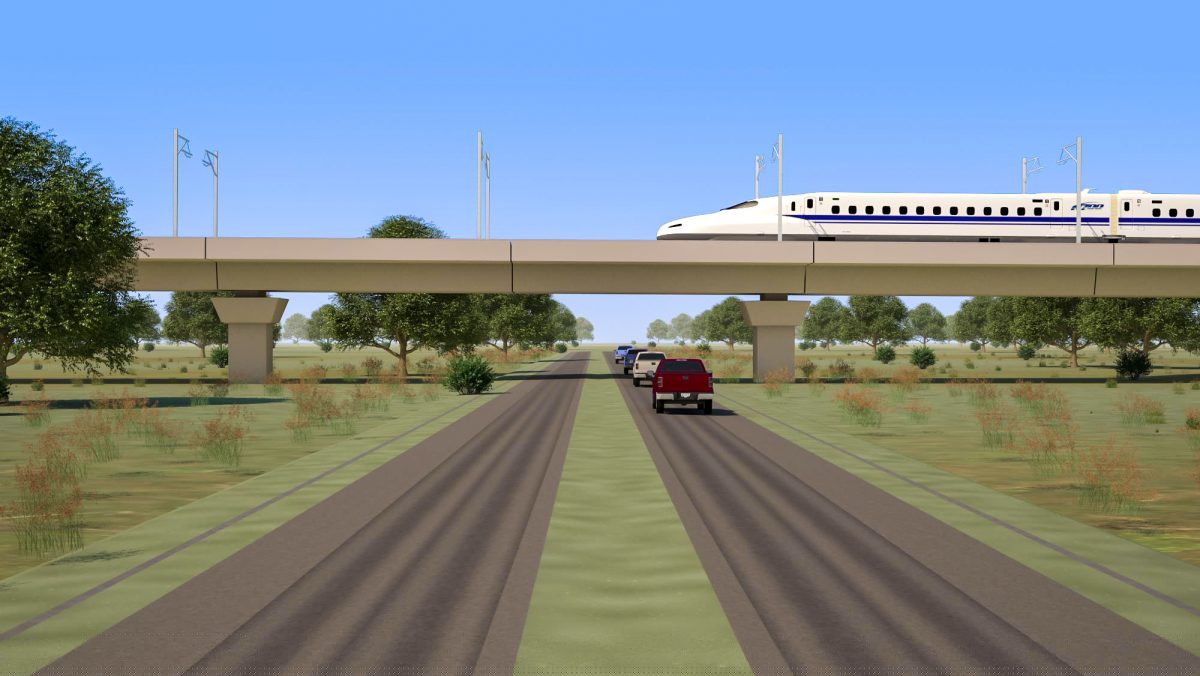Texas Central high-speed rail plans to create 90-minute travel between Houston and Dallas at up to 205 miles per hour by 2026.
Texas Central, the company behind the high-speed rail mega-project, recently announced a partnership that signals the next major step in the progress of the bullet train. Salini Impregilo, a global engineering firm, and its American subsidiary Lane Construction has been brought on board the project to build all civil infrastructure for the rail line.
Additionally, Texas Central announced intent to use trains based on Japan’s Shinkansen system, taking their newest model and modifying it for American specifications. Holly Reed, Class of 1991 and the managing director for external affairs for Texas Central said she sees the partnership with Salini-Lane as the perfect fit for the project.
“They have built mega-projects around the world and brought them to completion and also have the scale to handle what we are building here in Texas,” Reed said. “And they’ve shown the attention to detail and ability to partner with local companies and make sure we work with minority, veteran and rural owned businesses, who are key partners.”
This high-speed rail project is the first of its kind in the United States, and this route was chosen from 97 different city pairs that were studied to find the best possible location. Being a fully private, investor-backed project, many different factors were taken into account to find a location that would be commercially viable, which includes geography. To begin construction, the project must pass two federal assessments: an environmental assessment and a Rule of Particular Applicability, Reed said
Throughout the North Texas, Brazos Valley and Houston route, there is only a 500-foot change in elevation, requiring no tunnels, and no major body of water to cross, making this route an ideal candidate for building.
“It’s about putting forward a set of safety regulations for how the train system will be operated and run in its current environment,” Reed said. “There are many general rules regarding passenger trains, but these are particular to this system and location that’s unique in having no at-grade crossing and going 205 miles per hour.”
The speed of the train would shrink the travel time between the Dallas and Houston areas down to less than 90 minutes, using the Shinkansen rail system, colloquially known as the “bullet train”, which first debuted in Japan in 1960. Texas Central will use a sixth-generation version of the train, the N700S, which is being rolled out before the 2020 Olympics in Tokyo. The Texas train will be modified for local specifics— to be ADA compliant, have no gap between train and platform and enhanced air conditioning, according to Reed.
Briggs Long, an international affairs graduate student, said he sees the project as a success for Texas A&M due to both its physical connectivity and educational opportunities.
“The ability to expand educational and internship opportunities for students, as well as further connecting the university to capital centers in Dallas and Houston, will be catalyzed by the introduction of high-speed rail in the Brazos Valley.”
According to Reed, relationships with all levels of government are important, regardless of the funds behind this project. In addition to the two major federal approvals – both under the auspices of the Department of Transportation’s Federal Railway Administration – Texas Central works with local and state elected officials to attempt to find cohesion on long term plans and to minimize the disruption that construction will cause.
Reed estimates that construction to start by the end of 2020 and be completed by 2026. However, there has been some pushback on the project, especially from some of the more rural areas that the track will go through, according to Blane Counsil, agricultural economics, and public policy analysis senior.
“It affects my family, friends, and community,” Counsil said. “The use of eminent domain to build the tracks cuts through the land of farmers and ranchers, and while compensation is given, sometimes the land is split in ways that make it difficult to use effectively.”
Reed said that Texas Central is very optimistic about the project as it is the first of its kind in the country.
“It’s an exciting, transformational opportunity for the school,” Reed said.
Major milestone reached in plans for high-speed rail line
October 8, 2019
Photo by Provided
The Texas Central bullet train will create a 90 minute commute from Houston to Dallas.
0
Donate to The Battalion
$2065
$5000
Contributed
Our Goal
Your donation will support the student journalists of Texas A&M University - College Station. Your contribution will allow us to purchase equipment and cover our annual website hosting costs, in addition to paying freelance staffers for their work, travel costs for coverage and more!
More to Discover










